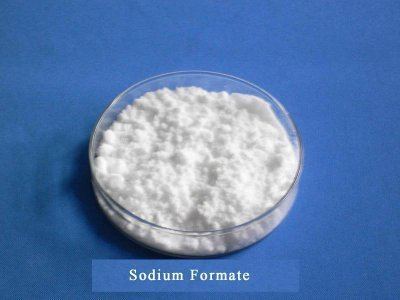Formula HCOONa Melting point 253 °C | Molar mass 68.01 g/mol Density 1.92 g/cm³ | |
 | ||
Appearance white granules; deliquescent | ||
Sodium formate, HCOONa, is the sodium salt of formic acid, HCOOH. It usually appears as a white deliquescent powder.
Contents

Sodium formate meaning
Preparation

For commercial use, sodium formate is produced by absorbing carbon monoxide under pressure in solid sodium hydroxide at 130 °C and 6-8 bar pressure:
CO + NaOH → HCO2Na
Because of the low-cost and large-scale availability of methanoic acid by carbonylation of methanol and hydrolysis of the resulting methyl formate, sodium formate is usually prepared by neutralizing methanoic acid with sodium hydroxide. Sodium formate is also unavoidably formed as a by-product in the final step of the pentaerythritol synthesis and in the crossed Cannizzaro reaction of methanal with the aldol reaction product trimethylol acetaldehyde [3-hydroxy-2,2-bis(hydroxymethyl)propanal].

In the laboratory, sodium formate can be prepared by neutralizing formic acid with sodium carbonate. It can also be obtained by reacting chloroform with an alcoholic solution of sodium hydroxide.
or by reacting sodium hydroxide with chloral hydrate.
The latter method is, in general, preferred to the former because the low aqueous solubility of CHCl3 makes it easier to separate out from the sodium formate solution, by fractional crystallization, than the soluble NaCl would be.
Sodium formate may also be created via the haloform reaction between ethanol and sodium hypochlorite in the presence of a base. This procedure is well documented for the preparation of chloroform.
Physical properties
Sodium formate crystallizes in a monoclinic crystal system with the lattice parameters a = 6,19 Å, b = 6,72 Å, c = 6,49 Å und β = 121,7°.
Chemical properties
On heating, sodium formate decomposes to form sodium oxalate and hydrogen. The resulting sodium oxalate can be converted by further heating to sodium carbonate upon release of carbon monoxide:
As a salt of a weak acid (methanoic acid) and a strong base (sodium hydroxide) sodium formate reacts in aqueous solutions basic:
A solution of formic acid and sodium formate can thus be used as a buffer solution.
Sodium formate is slightly water-hazardous and inhibits some species of bacteria but is degraded by others.
Uses
Sodium formate is used in several fabric dyeing and printing processes. It is also used as a buffering agent for strong mineral acids to increase their pH, as a food additive (E237), and as a de-icing agent.
In structural biology, sodium formate can be used as a cryoprotectant for X-ray diffraction experiments on protein crystals, which are typically conducted at a temperature of 100 °K to reduce the effects of radiation damage.
Sodium formate plays a role in the synthesis of methanoic acid, it is converted by sulfuric acid via the following reaction equation:
The urticating hair of stinging nettles contains in addition to formic acid also sodium formate.
Solid sodium formate is used as a non-corrosive agent at airports for de-icing of runways in mix with corrosion inhibitors and other additives, which rapidly penetrate solid snow and ice layers, detach them from the asphalt or concrete and melt the ice rapidly.
The high freezing point depression e.g. in comparison to the still frequently used urea (which is effective but problematic due to eutrophication) effectively prevents the re-icing, even at temperatures below −15 °C. The thawing effect of the solid sodium formate can even be increased by moistening with aqueous potassium formate or potassium acetate solutions. The degradability of sodium formate is particularly advantageous with a chemical oxygen demand (COD) of 211 mg O2/g compared with the de-icing agents sodium acetate (740 mg O2/g) and urea with (> 2,000 mg O2/g).
Saturated sodium formate solutions (as well as mixtures of other alkali metal formates such as potassium and cesium formate) are used as important drilling and stabilizing aids in gas and oil exploration because of their relatively high density. By mixing the corresponding saturated alkali metal formate solutions any densities between 1,0 and 2,3 g/cm3 can be set. The saturated solutions are biocidal and long-term stable against microbial degradation. Diluted, on the other hand, they are fast and completely biodegradable. As alkali metal formates as drilling aids make it unnecessary to add solid fillers to increase the density (such as barytes) and the formate solutions can be recovered and recycled at the drilling site, formates represent an important advance in exploration technology.
